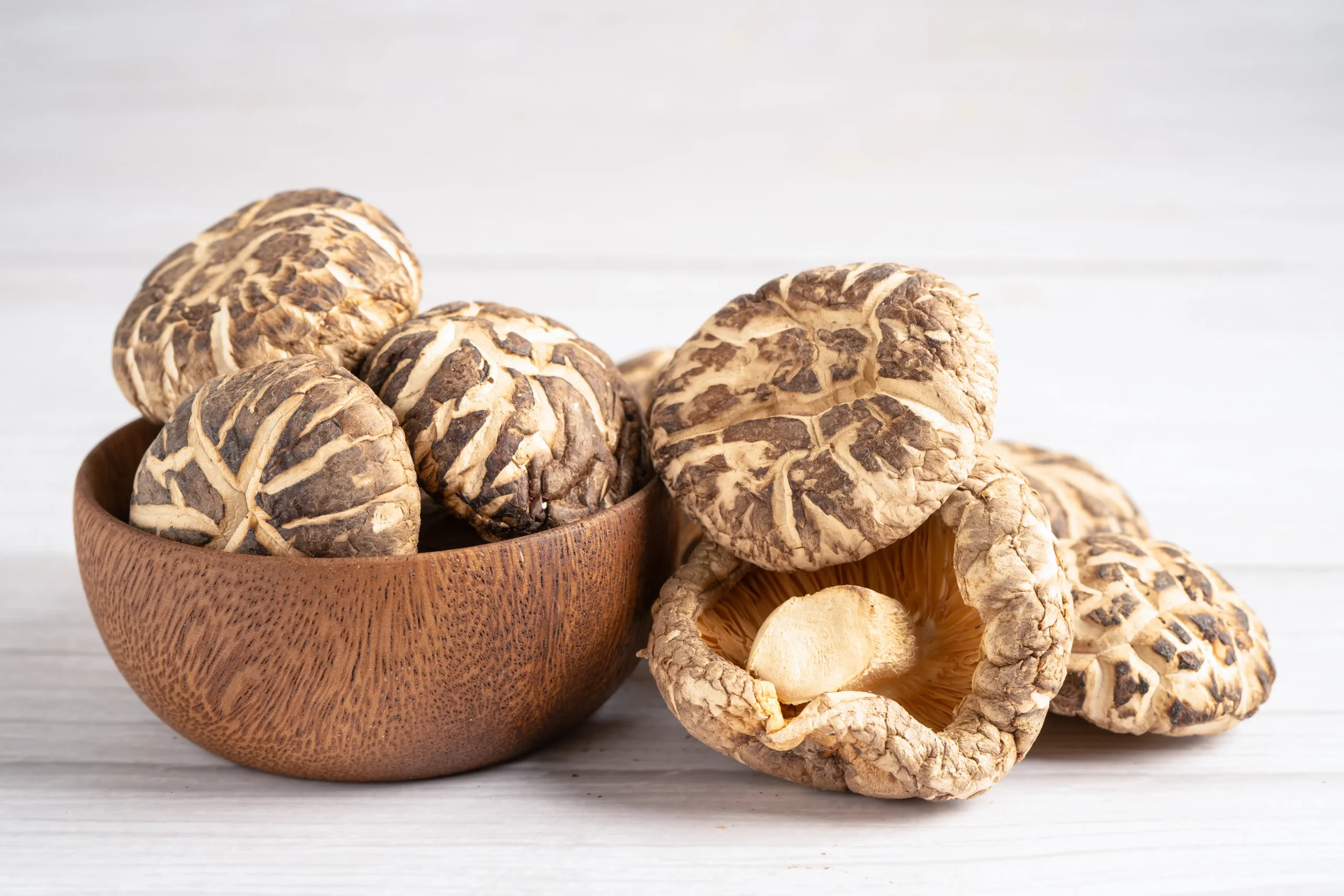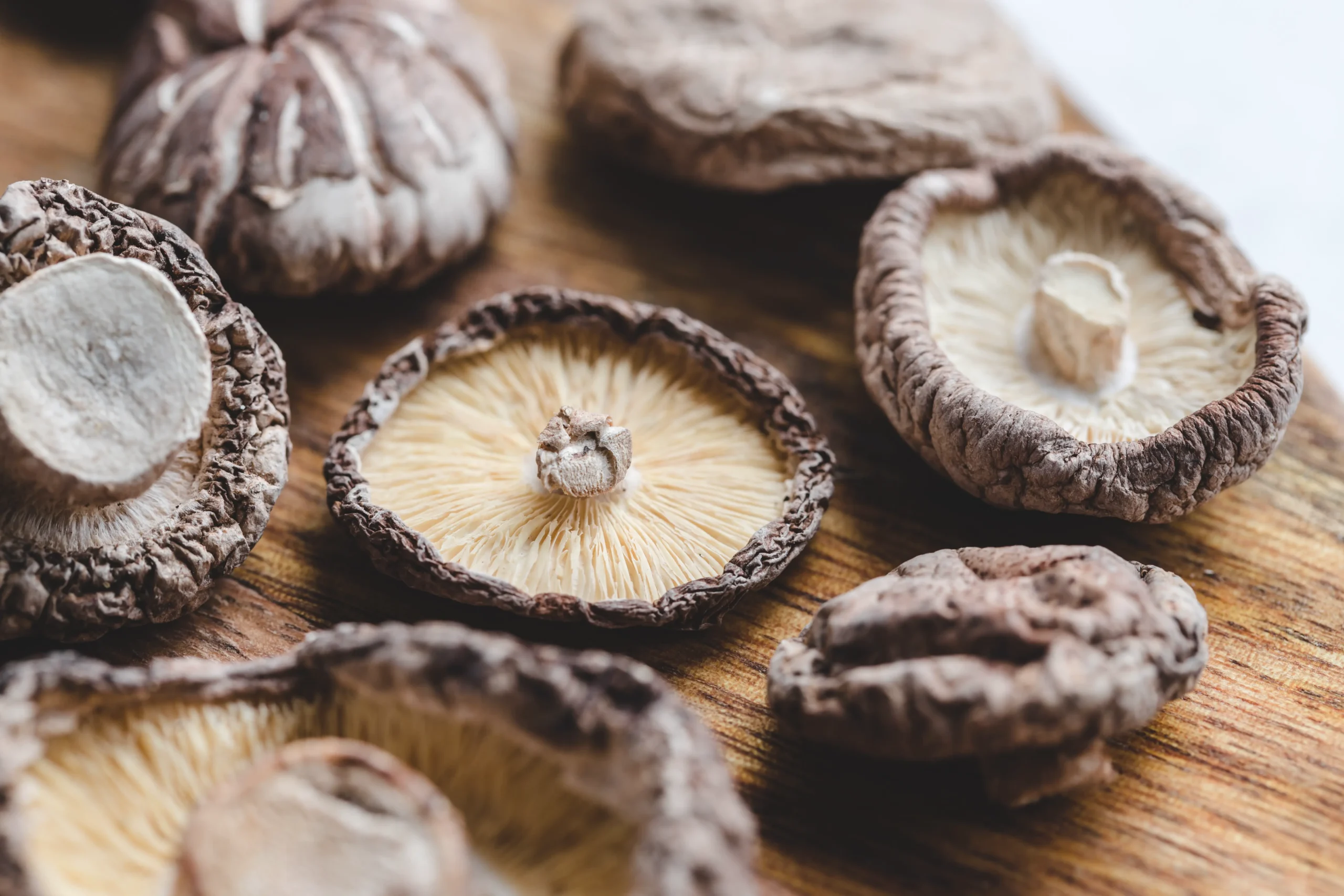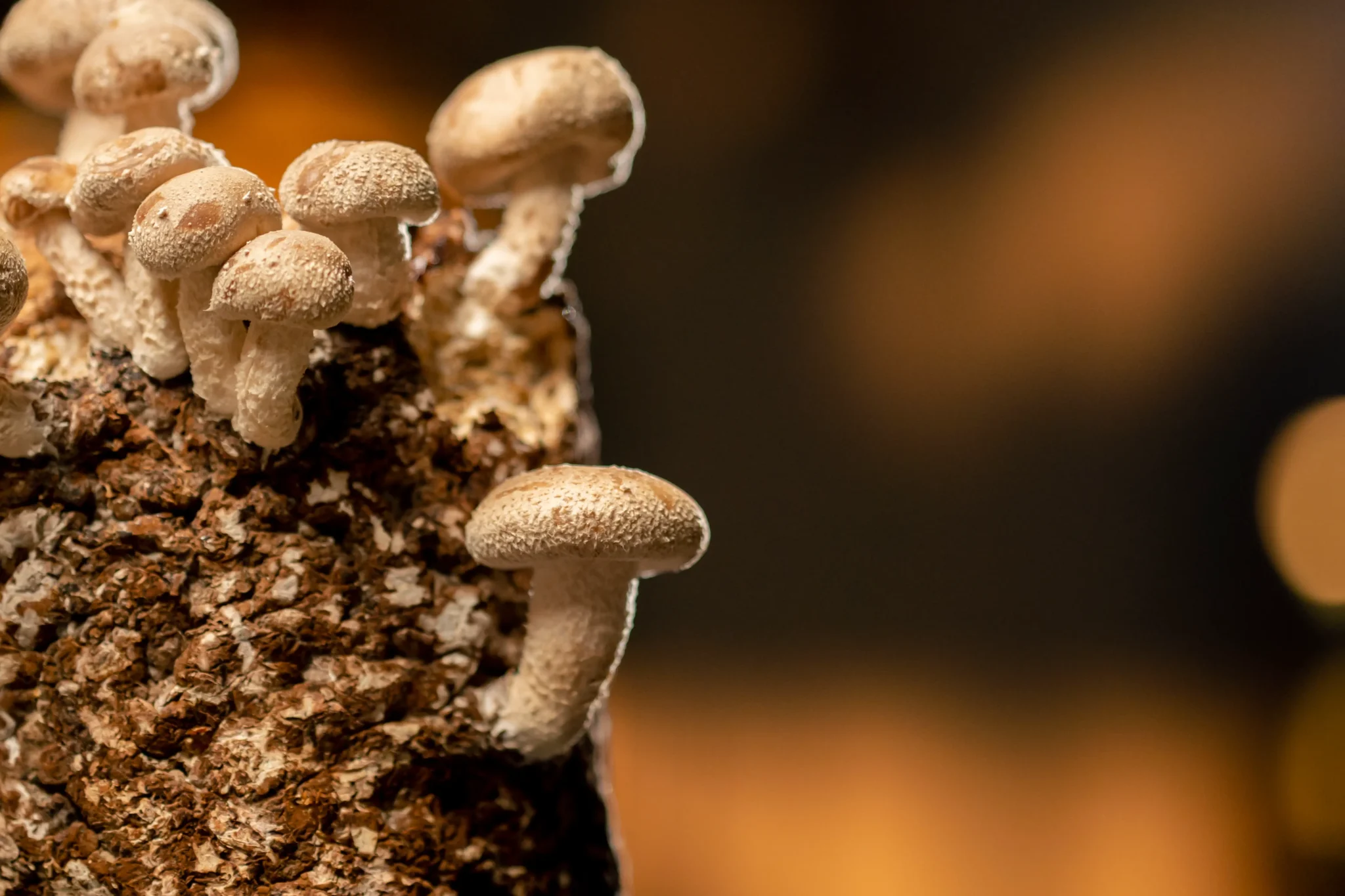Your Complete Practical Guide to Shiitake Cultivation
From small kitchens to shady gardens: Anyone wanting to grow shiitake mushrooms needs only the right spawn, thoughtful climate management, and some patience. In this comprehensive guide, you’ll learn everything you need to know – from substrate selection to perfect harvesting techniques, plus advanced methods for maximizing yields and quality.
Why Grow Shiitake at Home?
- Taste & Freshness: Freshly harvested shiitake mushrooms develop an intense umami flavor that surpasses store-bought varieties by orders of magnitude.
- Health Benefits: Lentinan and eritadenin compounds strengthen the immune system, support cardiovascular health, and promote healthy cholesterol metabolism.
- Sustainability: Growing shiitake mushrooms reduces transportation footprints, packaging waste, and food miles while providing year-round local nutrition.
- Versatile Methods: Whether using logs, substrate blocks, coffee grounds, or straw – there’s a suitable solution for every living situation and skill level.
- Economic Benefits: Home cultivation can yield 2-4 pounds of premium mushrooms per year from a single log, with retail value of $30-60.
- Educational Value: Understanding fungal cultivation provides insights into decomposition cycles, sustainable agriculture, and mycoremediation principles.

Biology and Environmental Requirements of Shiitake Mushrooms
Optimal Growth Parameters
| Phase | Temperature | Humidity | Light | Duration |
|---|---|---|---|---|
| Colonization (Mycelial Growth) | 68–75°F (20–24°C) | 70–80% | Dark | 6-12 weeks |
| Fruiting (Mushroom Formation) | 54–64°F (12–18°C) | 85–95% | Indirect daylight / 300–500 lux | 7-14 days |
| Rest Period | 60–70°F (15–21°C) | 60–70% | Minimal | 4-8 weeks |
Whether you’re just starting to grow shiitake mushrooms or have experience, these parameters determine cap size, texture, and flavor intensity. Understanding the biological needs helps optimize yields and prevents common cultivation failures.
Understanding Shiitake Strains and Their Characteristics
Cold Weather Strains
- WR46: Excellent for log cultivation, fruits in 45-60°F, thick meaty caps
- Cold Forest: Adapts to outdoor temperature fluctuations, reliable producer
- Snow Cap: Premium white variety, fruits in temperatures as low as 40°F
Warm Weather Strains
- WR74: Indoor cultivation favorite, fruits at 65-75°F, fast colonizer
- 3782: Heat tolerant, excellent for warmer climates, consistent yields
- Warm Forest: Balanced strain for year-round indoor production
Specialty Strains
- Phoenix Oyster Hybrid: Shiitake-oyster cross, unique flavor profile
- Donko Type: Traditional thick-capped variety, premium culinary grade
- Fast Flush: Rapid fruiting strain, harvest in 5-7 days
Spawn Types: Starting with the Right Mycelium
Dowel Spawn
Wooden dowels pre-colonized with mycelium are ideal for log cultivation. They provide clean inoculation points and reduce contamination risk. Best for beginners and outdoor cultivation where sterile technique is challenging.
Grain Spawn
Wheat, rye, or millet grains offer multiple inoculation points for rapid colonization of substrate blocks. The high contact surface accelerates mycelial spread, making it perfect for indoor growing and commercial production.
Sawdust Spawn
Finely distributed mycelium on wood chips integrates excellently with coffee ground mixtures, straw, and supplemented substrates. Provides even distribution and consistent colonization rates.
Liquid Culture
Advanced method using liquid medium for rapid mycelial propagation. Allows for large-scale inoculation and faster initial growth phases. Requires sterile technique and specialized equipment.
Growing Shiitake on Logs – The Traditional Garden Method
For those wanting to grow shiitake mushrooms on logs, follow this comprehensive step-by-step process:
Log Selection and Preparation
- Choose the Right Wood: Fresh oak, beech, maple, or sweet gum logs, diameter 4-8 inches, length 3-4 feet
- Timing Matters: Cut logs during dormant season (late fall to early spring) when sap content is lowest
- Aging Process: Let logs rest 2-6 weeks to allow natural antifungal compounds to diminish
Inoculation Process
- Drill Pattern: Create holes 6 inches apart in diamond pattern, 5/16 inch diameter, 1.5 inches deep
- Insert Spawn: Hammer dowels flush with bark surface using rubber mallet
- Seal Holes: Cover with cheese wax or beeswax to prevent contamination and moisture loss
- End Sealing: Paint cut ends with wax to prevent competing fungi entry
Incubation Management
- Stacking: Create log stacks in shaded area with 80% shade cloth
- Moisture Management: Maintain 35-45% moisture content through regular watering
- Monitoring: Check for white mycelial growth patterns after 6-8 weeks
- Patience Period: Allow 6-18 months for full colonization depending on log size
Fruiting Initiation
- Shock Treatment: Submerge fully colonized logs in cold water for 12-24 hours
- Alternative Shock: Use sudden temperature drops or heavy rain simulation
- Optimal Timing: Initiate fruiting when outdoor temperatures are 50-70°F
- Harvest Timing: Pick mushrooms when caps are 70% open but still firm
This method allows you to grow shiitake sustainably and achieve 3-4 productive flushes annually for 3-5 years per log.
Shiitake in Substrate Blocks – Fast Indoor Results
Advanced Substrate Formulations
Basic Formula
- 80% hardwood sawdust (oak, beech, maple preferred)
- 18% wheat bran or rice bran
- 2% gypsum for pH buffering and calcium
- Moisture content: 60-65%
Enhanced Formula
- 70% mixed hardwood sawdust
- 15% wheat bran
- 10% soybean hulls
- 3% gypsum
- 2% lime for pH adjustment (6.0-6.5)
Premium Formula
- 65% oak sawdust
- 15% wheat bran
- 10% cotton seed hulls
- 5% corn cobs (ground)
- 3% gypsum
- 2% lime
Sterilization vs. Pasteurization
Sterilization Method
- Pressure Cooker: 250°F (121°C) for 2 hours at 15 PSI
- Advantages: Complete pathogen elimination, lower contamination risk
- Disadvantages: Energy intensive, requires pressure cooker
Pasteurization Method
- Hot Water Bath: 160°F (71°C) for 2 hours
- Oven Method: 180°F (82°C) for 3 hours in covered containers
- Steam Method: Steam at 180°F for 2 hours
Inoculation and Incubation
- Cool Down: Allow substrate to reach 75°F before inoculation
- Spawn Rate: Use 10-20% spawn by weight for optimal colonization
- Mixing: Distribute spawn evenly throughout substrate
- Bagging: Pack into filter patch bags or make micropore filter holes
- Incubation: Store at 75°F (24°C) in dark location for 4-6 weeks
Fruiting Block Management
- Initiation: Move fully colonized blocks to fruiting chamber
- Cutting: Make X-shaped cuts 2 inches long on multiple sides
- Shocking: Submerge briefly in cold water or mist heavily
- Environment: Maintain 85-90% humidity, 60-65°F temperature
Innovative Growing Methods
Coffee Ground Cultivation
For those interested in growing shiitake on coffee grounds, this sustainable method recycles waste into food:
Preparation Method
- Collect fresh coffee grounds within 24 hours of brewing
- Mix 40% coffee grounds with 60% pasteurized straw pellets
- Add 5% wheat bran for nitrogen balance
- Adjust moisture to 65% and pH to 6.0-6.5
Critical Success Factors
- Coffee grounds must be free of additives and artificial flavors
- Pasteurize mixture at 160°F for 1 hour to eliminate competitors
- Ensure adequate drainage – pure coffee grounds compact too much
- Monitor for mold more frequently than traditional substrates
Straw-Based Cultivation
Substrate Preparation
- Chop wheat or barley straw into 2-4 inch pieces
- Soak in lime water (pH 12) for 12-24 hours
- Rinse until pH drops to 8.0
- Layer with 15% hardwood sawdust
Hydroponic Integration
Advanced growers can integrate shiitake cultivation with hydroponic systems:
- Use spent substrate as growing medium for vegetables
- Capture mushroom watering runoff for hydroponic nutrient solution
- Create closed-loop systems reducing waste and water usage
Sterility and Hygiene – Preventing Contamination
Personal Hygiene Protocol
- Wash hands thoroughly with antibacterial soap
- Wear clean gloves and change frequently
- Use hair nets or caps to prevent contamination
- Avoid working when sick or after handling other organic materials
Equipment Sterilization
- Wipe all tools with 70% isopropyl alcohol before use
- Flame sterilize knives and inoculation tools
- Use pressure cooker for substrate containers
- Maintain separate tools for different cultivation areas
Environmental Controls
- Work in clean indoor spaces or under still air boxes
- Use HEPA filters in growing areas when possible
- Maintain positive air pressure in work areas
- Keep cultivation areas separate from food preparation
Contamination Identification
- Green Mold (Trichoderma): Bright green, spreads rapidly
- Black Mold (Aspergillus): Black spots, musty odor
- Bacterial Contamination: Slimy texture, foul smell
- Yeast Contamination: Wet, creamy appearance
Advanced Care: Climate, Light, and Water Management
Humidity Control Systems
DIY Humidity Solutions
- Humidity Tent: Clear plastic over wire frame with wet towels
- Perlite Bed: Layer of wet perlite under growing containers
- Automatic Misting: Timer-controlled spray systems
Professional Systems
- Ultrasonic Humidifiers: Precise control, minimal heating
- Steam Generators: Commercial-grade humidity management
- Evaporative Coolers: Humidity + temperature control
Lighting Requirements
Natural Light
- North-facing windows provide ideal indirect light
- Avoid direct sunlight which causes rapid moisture loss
- Use shade cloth to filter intense light
Artificial Lighting
- LED Strips: 5000K color temperature, 12-hour photoperiod
- Fluorescent Tubes: T5 or T8, 6500K daylight spectrum
- Intensity: 300-500 lux, measured at substrate surface
Ventilation Systems
Natural Ventilation
- Position growing areas near windows for air exchange
- Create cross-ventilation patterns
- Use convection to move stale air upward
Mechanical Ventilation
- Exhaust Fans: Remove stale air and excess CO₂
- Circulation Fans: Prevent stagnant air pockets
- Fresh Air Intake: Filtered incoming air
- Timer Controls: 15 minutes every 4 hours minimum

Seasonal Growing Strategies
Spring Cultivation (March-May)
- Ideal time for log inoculation as temperatures stabilize
- Start indoor substrate blocks for summer harvest
- Natural humidity levels support fruiting
- Prepare outdoor growing areas after frost danger passes
Summer Management (June-August)
- Increase watering frequency for log cultivation
- Use evaporative cooling for indoor growing
- Harvest early morning to avoid heat stress
- Focus on heat-tolerant strains
Fall Optimization (September-November)
- Peak season for outdoor shiitake production
- Natural temperature fluctuations trigger fruiting
- Prepare indoor spaces for winter growing
- Collect and process final outdoor harvests
Winter Production (December-February)
- Focus on indoor cultivation methods
- Utilize basement or garage spaces with heating
- Plan next year’s log inoculation schedule
- Process and preserve harvested mushrooms
Harvest, Storage, and Culinary Applications
Optimal Harvesting Techniques
- Timing: Harvest when caps are 60-80% open with slightly curled edges
- Method: Cut with sharp knife at base, leaving 1/4 inch stem
- Tool Hygiene: Clean knife between cuts to prevent contamination
- Gentle Handling: Support caps to prevent bruising
- Complete Harvest: Remove all mushrooms from cluster simultaneously
Post-Harvest Processing
- Cleaning: Brush away debris with soft brush, avoid washing
- Sorting: Separate by size and quality grades
- Trimming: Remove any damaged or tough portions
- Quality Check: Discard any with off-odors or discoloration
Storage Methods
Fresh Storage
- Refrigeration: 32-36°F in perforated bags, 7-10 days maximum
- Paper Bags: Allow air circulation, prevent moisture buildup
- Humidity Control: Maintain 85-90% relative humidity
Preservation Techniques
- Dehydration: 115°F until crisp, store in airtight containers
- Freezing: Sauté first, then freeze in portions
- Pickling: Marinate in vinegar-based solutions
- Salt Preservation: Layer with salt for traditional preservation
Culinary Applications
Preparation Techniques
- Grilling: Brush with oil, season, grill 3-4 minutes per side
- Sautéing: High heat, quick cooking to maintain texture
- Roasting: Oven at 400°F for 15-20 minutes
- Stuffing: Remove stems, stuff caps with various fillings
Flavor Pairings
- Asian Cuisine: Soy sauce, ginger, garlic, sesame oil
- European Style: Butter, herbs, wine, cream sauces
- Mediterranean: Olive oil, balsamic vinegar, fresh herbs
- Modern Fusion: Umami enhancers, fermented elements
Economic Analysis and Scaling Production
Cost-Benefit Analysis
Initial Investment (Small Scale)
- Spawn and substrate materials: $50-100
- Basic equipment (containers, spray bottles): $25-50
- Environmental controls (humidifier, thermometer): $50-100
- Total startup cost: $125-250
Ongoing Costs (Annual)
- Spawn replacement: $30-60
- Substrate materials: $40-80
- Utilities (heating, humidification): $100-200
- Total annual operating cost: $170-340
Revenue Potential
- Home production yield: 15-30 pounds annually
- Market value: $8-15 per pound fresh
- Potential gross income: $120-450
- Net profit potential: $0-110 (break-even to modest profit)
Scaling Considerations
Medium Scale (Commercial)
- Dedicated growing space: 200-500 sq ft
- Professional climate controls: $2,000-5,000
- Production capacity: 100-300 pounds annually
- Market channels: Farmers markets, restaurants, CSA
Large Scale (Industrial)
- Facility requirements: 1,000+ sq ft
- Automated systems: $10,000-50,000
- Production capacity: 500+ pounds annually
- Distribution networks: Wholesale, processing, export
Common Problems and Advanced Solutions
Growth Issues
Small, Dried Caps
- Cause: Insufficient humidity, excessive airflow
- Solution: Increase humidity to 90%, reduce air circulation
- Prevention: Install humidity monitoring systems
Long, Thin Stems
- Cause: Insufficient light, poor air exchange
- Solution: Increase lighting intensity, improve ventilation
- Prevention: Maintain 400-500 lux light levels
Contamination Issues
Green Mold on Substrate
- Immediate Action: Remove contaminated area with sterile knife
- pH Adjustment: Spray area with lime water (pH 10)
- Environmental Fix: Improve ventilation, reduce humidity
- Prevention: Better sterilization, cleaner work environment
Bacterial Soft Rot
- Recognition: Slimy texture, foul odor, rapid spread
- Treatment: Remove affected substrate immediately
- Disinfection: Clean area with hydrogen peroxide
- Prevention: Control moisture levels, improve drainage
Environmental Problems
Temperature Fluctuations
- Issue: Inconsistent fruiting, stressed mycelium
- Solution: Install thermal mass (water containers)
- Technology: Programmable thermostats, insulation
Humidity Extremes
- Too Low: Mushrooms abort, caps crack
- Too High: Bacterial growth, poor air quality
- Balance: Use hygrometers, automated misting systems
Quality Control and Standardization
Grading Standards
Premium Grade
- Cap diameter: 2-4 inches
- Uniform brown color
- Firm texture, minimal damage
- Partial veil intact
Commercial Grade
- Cap diameter: 1.5-5 inches
- Slight color variations acceptable
- Minor cosmetic defects allowed
- Good structural integrity
Safety Standards
Harvesting Safety
- Never consume mushrooms with unusual odors
- Avoid overmature specimens (fully opened caps)
- Check for insect contamination
- Maintain cold chain during storage
Processing Safety
- Use clean cutting surfaces
- Wash hands frequently during processing
- Maintain proper storage temperatures
- Follow HACCP principles for commercial operations
Advanced Breeding and Strain Development
Spore Collection
- Allow select mushrooms to fully mature
- Collect spore prints on sterile foil
- Store spores in sterile containers at 39°F
- Viability: 6-12 months under proper storage
Tissue Culture
- Clone superior mushroom specimens
- Maintain genetic consistency
- Develop location-specific adaptations
- Preserve rare or valuable strains
Hybrid Development
- Cross different shiitake strains
- Select for desired characteristics
- Test performance under local conditions
- Develop proprietary varieties

Comprehensive FAQ – Expert Answers to Common Questions
| Question | Answer |
|---|---|
| Can I grow shiitake mushrooms without an autoclave? | Yes, pasteurize substrate in oven at 180°F for 3 hours, or use outdoor log cultivation which requires no sterilization. |
| How long until first harvest from substrate blocks? | Typically 6-10 weeks after inoculation, with colonization taking 4-6 weeks and fruiting 7-14 days. |
| What temperature triggers fruiting? | A 48-72 hour temperature drop from 75°F to 55°F acts as a natural cold shock stimulus. |
| Can this guide work for oyster mushrooms? | Basic principles apply, but oyster mushrooms tolerate higher temperatures (65-75°F) and require less light. |
| How many flushes per log? | Well-managed logs produce 3-4 flushes annually for 3-5 years, totaling 12-20 harvest cycles. |
| What’s the best spawn-to-substrate ratio? | Use 10-20% spawn by weight for substrate blocks, 15-20% for faster colonization but higher costs. |
| How do I know if my substrate is properly colonized? | Look for white mycelial coverage, firm texture, and pleasant earthy smell throughout the substrate. |
| Can I reuse substrate after harvest? | Spent substrate makes excellent compost or growing medium for vegetables, but not for additional mushroom production. |
Sustainability and Environmental Impact
Waste Reduction Strategies
- Utilize agricultural waste products as substrate
- Compost spent substrate for garden applications
- Capture and reuse irrigation water
- Minimize packaging in direct-to-consumer sales
Carbon Footprint Considerations
- Local substrate sourcing reduces transportation emissions
- Energy-efficient LED lighting systems
- Passive climate control when possible
- Integration with renewable energy sources
Ecosystem Benefits
- Mushroom cultivation mimics natural decomposition
- Improves soil health through spent substrate addition
- Supports local food systems and biodiversity
- Reduces pressure on wild mushroom populations
Your Path to Aromatic Shiitake Success
Whether you choose to grow shiitake mushrooms on logs, substrate blocks, coffee grounds, or innovative new methods – success depends on clean starting materials, stable environmental conditions, and consistent practice. This comprehensive guide provides the foundation for both hobbyist and commercial cultivation.
The journey from spawn to harvest teaches patience, observation skills, and deep appreciation for fungal biology. Each successful flush builds confidence and expertise, leading to more adventurous projects and potentially profitable enterprises.
Key Success Factors:
- Start with high-quality spawn from reputable suppliers
- Maintain strict hygiene throughout all processes
- Monitor environmental conditions closely
- Learn from both successes and failures
- Connect with local mycological communities
- Scale operations gradually based on experience
The satisfaction of harvesting your own gourmet shiitake mushrooms – with their intense umami flavor and meaty texture – makes every effort worthwhile. From simple log inoculation to sophisticated controlled environment systems, shiitake cultivation offers endless opportunities for learning and improvement.
Take the next step: Order your spawn, prepare your substrate, and soon enjoy your first homegrown mushroom harvest! The world of fungal cultivation awaits your exploration.
